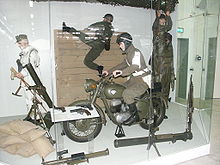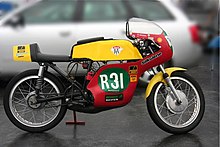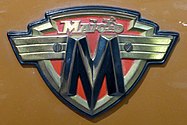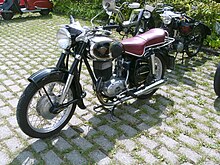Maico
| Maico
|
|
|---|---|
| legal form | |
| founding | 1926 |
| Seat | Pfäffingen , Germany |
| management |
|
| Branch | Bicycle manufacturer , automobile manufacturer |
Maico is the name of a family company in Pfäffingen near Tübingen in Swabia . It was founded in 1926 by Ulrich Maisch as Mai sch & Co mpagnons and began building bicycles and accessories. From around 1931 light motorcycles were also included in the production and sales program, now under the management of the company's sons, Otto and Wilhelm Maisch.
The beginnings
The first test versions of the Maico motorcycles were equipped with a 60 cm³ engine from the ILO engine works . Mainly 98 cm³ engines from Fichtel & Sachs and the more powerful 118 cm³ and 150 cm³ ILO engines were installed in series. The use of 60 cm³ ILO, Saxonette , 200 cm³ Bark and 125 cm³ Sachs engines in small numbers can also be proven.
As a result of the National Socialist government's Schell Plan , which aimed to reduce the variety of types in German vehicle construction, Maico was forced from 1939 to build a standard model together with the manufacturers Hecker , Tornax and UT . This model, the K 125 with a 125 cm³ ILO double port engine (single cylinder with two exhaust pipes) was developed by Maico and was also built in small numbers during the war, in addition to the production of parts for armaments production. The 98 cm³ and 118 cm³ models were still available for export.
Production after 1945
After the Second World War , Maico turned briefly to the manufacture of toys and wood gasifiers , but in view of the stormy demand for motor vehicles, he returned to building motorcycles, initially using the new 98 cm³ Sachs engine with Magura twist grip shift.
The production of the more attractive K 125 was slowed down by a lack of delivery capacity and quality problems of the engine supplier ILO-Süd in the American-occupied Munich and constant difficulties in introducing the scarce engines across the occupation zone border into the French-occupied Pfäffingen. Maico initially developed and produced improved replicas of ILO crankshafts and transmissions for spare parts, in order to present their own engine for the new M 125 model for the first time in autumn 1948. The M-125 engine (so-called Maico Spitz engine) designed by Willi Tetzlaff corresponds only visually to its ILO model, in fact it was a new development. The main differentiating feature to the ILO is the three-speed twist grip shift from Magura.
Versions of this engine with higher displacement were used in the M 150 and M 151 motorcycles and also in the “ Maicomobil ” MB 151 and MB 175 scooters . From the beginning of 1952, a new four-speed foot-operated gearbox in the old housing shape (so-called "Maico-Spitzmotor") was available for the M 175, MB 175 and a few M 151 models.
In 1953 the Maico engines were redesigned. The main dimensions were retained, the alternator was integrated into the housing, the external appearance was smoothed out and remained almost unchanged in this form until the appearance of the five-speed models 22 years later. This type of engine (so-called “Maico round engine”) was available in different displacement variants in the motorcycles M 175, M 200 “Fanal”, “Passat”, M 175 S, M 200 S, “M 250 / M 277 Blizzard”, the Motor scooters “Maicomobil MB 200” and “Maicoletta” 175, 250 and 277 and in numerous sports machines. Also in 1953, chief designer Ulrich Pohl designed a modern rear-wheel swing arm chassis, which was presented for the first time with the M175 S and M200 S models. The top model from 1953, however, was the "Taifun", an innovative two-cylinder two-stroke machine, optionally with 350 or 400 cm³ displacement. The 400 cm³ model developed 22.5 hp at 5200 rpm. Because of the dramatically shrinking motorcycle market, production of the Taifun had to be discontinued as early as 1957. Single-cylinder M models were produced until the early 1970s, especially the derivatives of the M250, e.g. B. the olive green Bundeswehrkrad M250 / B or the moss green Bavarian police motorcycle M250 / SII.
Maico cars
From 1954 on, the general interest in motorcycles in Germany subsided and the demand for small automobiles increased.
Like many other companies, Maico also produced small cars from 1955 to 1958 . The vehicles had an all-steel body, water-cooled Heinkel two-cylinder two-stroke in-line engines of 400 and 450 cm³ displacement with 15 and 18 hp respectively. They reached top speeds of 80 and 90 km / h. The first model was from September 1955 to June 1956 by the Rheinische automobile factory, Henning Thorndal acquired two-seater convertible saloon Champion H 400, from 1374 Maico piece almost unchanged as MC 400 / H built.
The four-seater type MC 500/4 presented at the IAA in 1955 was more successful , of which 6301 units were sold at a price of 3,665 DM. On the other hand, the MC 500 G combination model (a total of 21 pieces, price DM 4,500), the four-seater model MC 400/4 and the 110 km / h 20 hp 500 Sport model based on a design by Beutler , the up to In late 1957 it was produced (only 4 pieces). In addition to the 500 Sport, these models were also further developments of the Champion small car.
Because of the waning interest in street motorcycles and the less successful small car production, Maico relied on off-road and motocross machines from now on ; The sports equipment from Maico enjoyed a good reputation at that time and was successful.
Car disc brakes from Maico
In 1962 Maico bought a finished patent for a ring disc brake from the development company OJR (Oswald Josef Rosamowski) in order to utilize the weak production in winter with another business area. The Maico disc brake now being offered as a retrofit solution for cars should appeal to interested sports drivers as customers. In addition to the VW 1200 and 1500, Maico also offered conversion kits for the Porsche 356, the Karmann Ghia and the Peugeot 404.
Production from 1959 to 1967

From 1959 to 1961 Maico was able to deliver the military motorcycle model M 250 / B based on the Blizzard in a number of around 10,000 to the German Armed Forces and the Federal Border Police. The M 250 / B model replaced the previously used little off-road Triumph and DKW machines, whereby the factory had to enlist the help of the Zweirad-Union in Nuremberg for domestic political reasons and because of the high number of units. The Zweirad-Union assembled about a third of the machines produced; however, Maico also supplied the motor, tank, forks and hubs for the motorbikes made in Nuremberg.
A new attempt in the field of street motorcycles in the mid-1960s began problematically. Maico hoped for lucrative business on the US market with a modern 125 cc rotary vane engine. However, the MD 125 model with a nominal output of 11 hp, released in 1966, disappointed and the lucrative US business did not materialize. In addition, the motorcycle was not eligible for approval in Germany due to the low generator power. After a fundamental redesign of the engine by Günther Schier, the breakthrough came. The engine had a stable 14.5 HP as early as 1967 and had a sufficiently dimensioned generator. Nothing stood in the way of a German approval. Maico was one step ahead of the competition with the MD 125. However, there was almost no market for 125 cc motorcycles in Germany at that time, so that commercial success failed to materialize. In the RS 125 racing machine , the engine delivered over 30 hp in its most successful period and won three world championship races in the class up to 125 cm³ with Börje Jannson.
The big competition

In 1967 a small motorcycle appeared in the chassis of the MD 125 (a motorcycle class of up to 50 cm³ displacement that is no longer used in Germany today) under the designation MD 50, a model with rotary valve control . However, with this model, Maico was not in a position to endanger the dominance of the Kreidler , Zündapp and Hercules machines in this market segment, not least due to various manufacturing defects that adhered to the MD 50 and could not be completely eliminated. The six-speed gearbox (from 1972), which was unusual at the time, the excellent chassis, the low-maintenance engine due to the design and the low purchase price compared to the competition did not prevent the MD 50 from having a bad reputation. Also the MD 250, a 250 cm³ variant, most recently the water-cooled version MD 250 WK on the market, and the attempt to sell a motorcycle for road racing in larger numbers with the Maico 125 RS built in the 1970s , brought Maico no commercial success. The RS 125, with a top speed of 190 km / h, was offered until 1974, most recently for 6170.00 DM, which corresponds to a current price of 8,800 euros.
On the other hand, the off-road motorcycles developed by Maico from the mid-1960s onwards, which established the company's success with a large number of successes in motocross sport in the 1970s, had an almost legendary reputation. Contrary to other statements, however, Maico did not succeed in achieving a motocross world title. In addition to Åke Jonsson , Adolf Weil and Willy Bauer , Hans Maisch , the son of Wilhelm Maisch, was one of the successful Maico works drivers.
Since 1985
After economic problems - not least because of disputes within the Maisch family - the third bankruptcy occurred in the mid-1980s, in which the family company was finally dissolved.
In 1987, industrial supplier Lorenz Merkle took over the remainder of the company, including the brand name. The company headquarters at that time was Nördlingen / Bavaria and later Bopfingen / Baden-Württemberg. It began with a redesign of the Maico motorcycles, which included innovations such as a diesel-powered twin-disc rotary engine . These ideas did not materialize. Conventional Maico motorcycles were manufactured in the Netherlands from 1995 to 1999. Since then, the Leverkusen motorcycle dealer Zweirad Köstler GbR has been manufacturing small numbers of motorcycles under the name Maico. The current range includes motocross, enduro and supermoto machines with water-cooled single-cylinder two-stroke engines from 250 to 685 cm³.
In 2010 the word mark was changed to Otto Maisch's daughter, Ingrid di Censo.
literature
- Frank O. Hrachowy: Maico Motorcycles: History - Types - Technology , Verlag Vennekate, Lemgo 2005, ISBN 978-3-935-51721-8 .
- Frank Rönicke: Maico: Motorräder 1934–1994 , Motorbuch-Verlag, Stuttgart 2007, ISBN 978-3-613-02812-8
- Jan Leek: Maico Motorräder 1934–1987 (documentation), Schrader Verlag, Stuttgart 2002, ISBN 3-613-87214-5
Individual evidence
- ^ Maico company history , accessed on April 1, 2018.
- ↑ Frank O. Hrachowy: Maico motorcycles . Verlag Johann Kleine Vennekate, Lemgo 2005, ISBN 3935517211 .
- ^ 1974 motorcycle catalog . Motor-Presse-Verlag, Stuttgart 1973, p. 28.
- ↑ Maico models, accessed November 5, 2015
Web links
- Maico M 250 B in the Moped Museum
- MAICO friends Germany
- Report of a classic car club about the Typhoon, with photo





